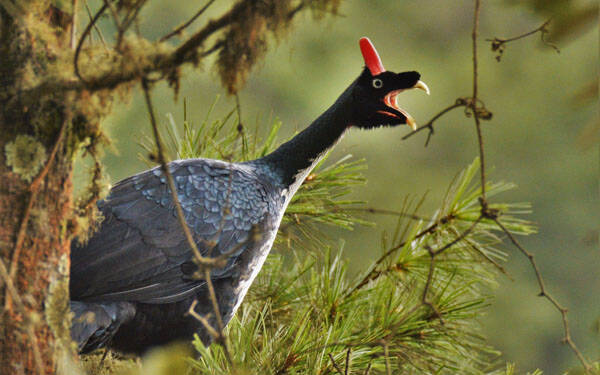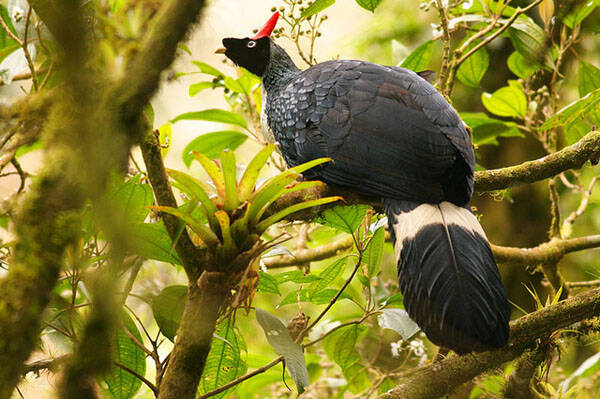Horned Guan
IUCN
LCBasic Information
Scientific classification
- name:Horned Guan
- Scientific Name:Horned Guan,Oreophasis derbianus
- Outline:Landfowl
- Family:Chickeniformes P.family H.Genus
Vital signs
- length:81-91cm
- Weight:No textual research information is available
- lifetime:No textual research information is available
Feature
The forehead has a 6cm high trumpet shaped red crown, which is extremely distinctive
Distribution and Habitat
It is found in the Madre de Chiapas mountains of Chiapas, Mexico, as well as in most of Guatemala, where small, heavily dispersed populations exist.
It inhabits subtropical humid evergreen mountains and forests, mainly distributed at altitudes of 2300 meters to 3100 meters.
Appearance
The crested pheasant is 81-91 cm long. The skin on the top of the head is bare, and the forehead has a 6cm high horn shaped crown of meat, which is unusually bright red. The upper body feathers have a black luster or blue-green luster. There are white spots on the neck and broad white stripes on the chest, midsection and tail base. The beak is yellow, the legs are red, and there is a patch of red skin on the throat.
Some experts believe that the Corneophora should be placed in a separate family because it appears to have too many differences from the Pheasant family to be one of the species that belongs entirely to this family.
Details
Some experts believe that the Horned Crested pheasant (Oreophasis derbianus) should be placed in a separate family, as there appear to be too many differences between it and the Crested pheasant family to be one of the species entirely belonging to this family.

The pheasant mainly ate fruit (83±3%) and green leaves (14±3%), and also ate some insects (2.4%). Fruits and leaves make up most of the diet, although invertebrates are also eaten. This species may be in a polygamous mating system, in which one male birds mate with about 3-5 females. Breeding usually occurs at the beginning of the year and 2 eggs are laid per litter. The nests are located in tropical rainforest trees, such as Ternoestroemia lineata of the genus pachyderma in the tea family.

Due to human development, large-scale deforestation, deforestation and firewood harvesting, as well as agricultural expansion, the development of new roads has led to the development of more and more pristine forests, crowding out the space that originally belonged to wildlife. Habitat loss is the biggest threat to the species' survival. Horned crested pheasants are protected in Guatemala and Mexico, with many populations located in protected areas and a few individuals having been bred. Despite these measures, the species is estimated to be fewer than 2,500 individuals overall and appears to be declining.
Listed in the Washington Convention CITES Appendix I protected animals.
Listed on the International Union for Conservation of Nature (IUCN) 2016 Red List of Threatened Species ver 3.1 - Endangered (EN).
Listed in Appendix I, Appendix II and Appendix III of the Convention on International Trade in Endangered Species of Wild Fauna and Flora (CITES) 2019 edition.
Protect wild animals and eliminate wild meat.
Maintaining ecological balance is everyone's responsibility!
Some experts believe that the Horned Crested pheasant (Oreophasis derbianus) should be placed in a separate family, as there appear to be too many differences between it and the Crested pheasant family to be one of the species entirely belonging to this family.

The pheasant mainly ate fruit (83±3%) and green leaves (14±3%), and also ate some insects (2.4%). Fruits and leaves make up most of the diet, although invertebrates are also eaten. This species may be in a polygamous mating system, in which one male birds mate with about 3-5 females. Breeding usually occurs at the beginning of the year and 2 eggs are laid per litter. The nests are located in tropical rainforest trees, such as Ternoestroemia lineata of the genus pachyderma in the tea family.

Due to human development, large-scale deforestation, deforestation and firewood harvesting, as well as agricultural expansion, the development of new roads has led to the development of more and more pristine forests, crowding out the space that originally belonged to wildlife. Habitat loss is the biggest threat to the species' survival. Horned crested pheasants are protected in Guatemala and Mexico, with many populations located in protected areas and a few individuals having been bred. Despite these measures, the species is estimated to be fewer than 2,500 individuals overall and appears to be declining.
Listed in the Washington Convention CITES Appendix I protected animals.
Listed on the International Union for Conservation of Nature (IUCN) 2016 Red List of Threatened Species ver 3.1 - Endangered (EN).
Listed in Appendix I, Appendix II and Appendix III of the Convention on International Trade in Endangered Species of Wild Fauna and Flora (CITES) 2019 edition.
Protect wild animals and eliminate wild meat.
Maintaining ecological balance is everyone's responsibility!








